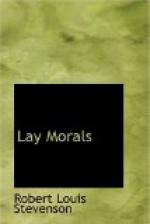’Did print
The azure air with pines.’
Moreover, I do not recollect in the author’s former work any symptom of that sympathetic treatment of still life, which is noticeable now and again in the fables; and perhaps most noticeably, when he sketches the burned letters as they hover along the gusty flue, ’Thin, sable veils, wherein a restless spark Yet trembled.’ But the description is at its best when the subjects are unpleasant, or even grisly. There are a few capital lines in this key on the last spasm of the battle before alluded to. Surely nothing could be better, in its own way, than the fish in ’The Last Cruise of the Arrogant,’ ‘the shadowy, side-faced, silent things,’ that come butting and staring with lidless eyes at the sunken steam-engine. And although, in yet another, we are told, pleasantly enough, how the water went down into the valleys, where it set itself gaily to saw wood, and on into the plains, where it would soberly carry grain to town; yet the real strength of the fable is when it dealt with the shut pool in which certain unfortunate raindrops are imprisoned among slugs and snails, and in the company of an old toad. The sodden contentment of the fallen acorn is strangely significant; and it is astonishing how unpleasantly we are startled by the appearance of her horrible lover, the maggot.
And now for a last word, about the style. This is not easy to criticise. It is impossible to deny to it rapidity, spirit, and a full sound; the lines are never lame, and the sense is carried forward with an uninterrupted, impetuous rush. But it is not equal. After passages of really admirable versification, the author falls back upon a sort of loose, cavalry manner, not unlike the style of some of Mr. Browning’s minor pieces, and almost inseparable from wordiness, and an easy acceptation of somewhat cheap finish. There is nothing here of that compression which is the note of a really sovereign style. It is unfair, perhaps, to set a not remarkable passage from Lord Lytton side by side with one of the signal masterpieces of another, and a very perfect poet; and yet it is interesting, when we see how the portraiture of a dog, detailed through thirty odd lines, is frittered down and finally almost lost in the mere laxity of the style, to compare it with the clear, simple, vigorous delineation that Burns, in four couplets, has given us of the ploughman’s collie. It is interesting, at first, and then it becomes a little irritating; for when we think of other passages so much more finished and adroit, we cannot help feeling, that with a little more ardour after perfection of form, criticism would have found nothing left for her to censure. A similar mark of precipitate work is the number of adjectives tumultuously heaped together, sometimes to help out the sense, and sometimes (as one cannot but suspect) to help out the sound of the verses. I do not believe, for instance, that Lord Lytton himself would




